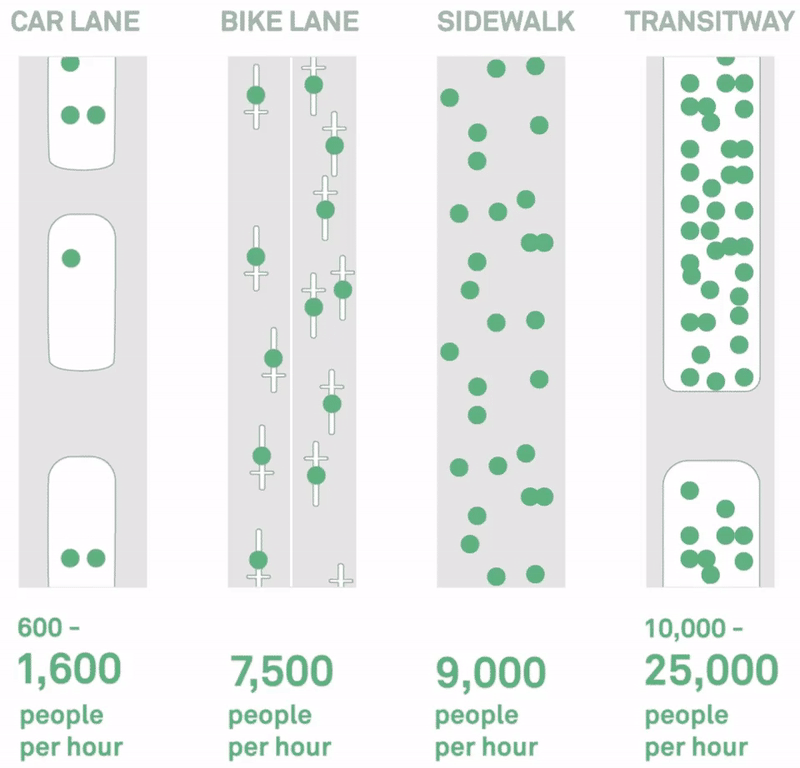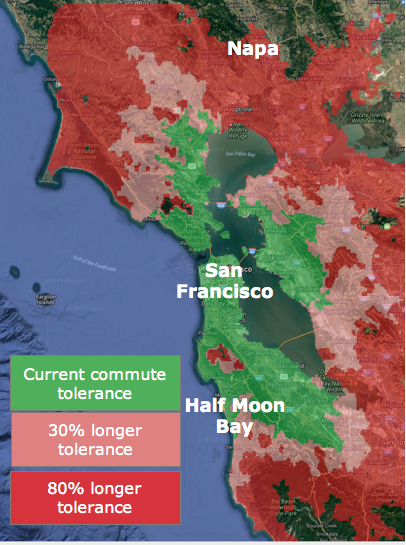Self-Driving Cars Make Traffic Worse
It doesn’t matter how efficient you make a car. It’s still a car

A self-driving car is still a car. That’s the problem. It doesn’t matter how efficient you make self-driving cars, it doesn’t matter how much AI you throw at it. In an urban setting, which 50% of the world is, private vehicles will never be as efficient as public transit. The billions of dollars spent on self-driving is an engineer’s dream and a capitalist’s fantasy. It will be a nightmare for regular human beings.
The Problem Of Traffic
As you can see from the GIF above, cars are just a colossal bad use of space. They transport very the least people using the most space. This is the transport tragedy of the commons. By giving over public roads to private vehicles, we have ruined the whole thing. This is not to say that private vehicles have no utility, but they should have never been the center of transport planning. It leads to disaster.
I have seen this tragedy play out in my own city. In Colombo, public transport has never improved. I first took the bus with my grandmother and the buses are exactly the same. As soon as anyone gets the money they get a car, so they can be comfortable and not have a dick on their shoulders. This is where the tragedy begins.
Driving is a sensible personal decision, and a collective disaster. It’s fairly simple math.
Just look at the GIF above. A bus lane can transport 10,000 people an hour. A car lane can transport 600. As more people switch to cars, your traffic gets worse and worse. Comfort leads to congestion. This is the tragedy of the commons.
The Solution Of Self-Driving Cars
Self-driving cars have been promoted as the solution to this problem. The idea is that they will be more efficient and decrease traffic while allowing us to keep our personal vehicles. But the math just doesn’t hold up. At all.
Let’s say that self-driving makes car lanes 20% more efficient. Then suddenly a car lane is moving 720 people per hour. This is still 14x worse than a bus. Self-driving cars would have to be 1700% more efficient than a regular car in order to even match public transit. And they’re not. That’s just not possible.
Point-to-point transport will simply never be as efficient and public transit on fixed routes. Furthermore, self-driving cars will mix with human-driven cars for at least a decade. Traffic will only be as efficient as the worst driver, so for years, we may see no gain at all.
And this is before you factor in all the negative impacts. Which are many.
The Problem Of Self-Driving Cars
Self-driving cars would certainly be is more comfortable. They could be designed as traveling TV rooms, or bedrooms. The wealthy can be comfortably ensconced, even while on a two-hour commute. But God helps the towns they’re passing through.

Right now your commute is what you’ll tolerate. If your car is more comfortable, you’ll tolerate it more. This map calculates what urban sprawl would look like at different rates of tolerance. With 80% more tolerance, people will commute to San Francisco from as far away as the Napa Valley.
This increase in people will completely outweigh any efficiency gains. Which city planners have seen again and again. If you build more roads you get more traffic. If you make cars more efficient, you get more traffic.
The better self-driving cars get, the worse it will make our cities.
The Other Problems Of Self-Driving Cars
Self-driving cars also have unique negatives. In our example above, a VC can commute from their vineyard to the city, sleeping or watching Netflix on the ride. Once in the city, they won’t park their car, instead, their vehicle will earn money for them, like a cab. This turns the tragedy of the commons to outright rape and pillage.
Uber and Lyft already make traffic worse in many cities, contributing up to 14% of vehicle miles. Nearly half the time these cabs are riding empty — deadheading, waiting for a hire. Your self-driving car may not take up a parking space, which is great for you, but it will take up the road, which is bad for everyone else.
All of these extra commuters will bring all of their extra cars, and they will clog up the streets, making money for them and misery for everyone else. More traffic.
I return again to the classic tautology of urban planning. More roads equal more traffic. A more efficient car is equivalent to adding another lane. It will just fill and you’ll get more gridlock.
The problem with cars isn’t that they’re not self-driving. The problem is that they’re cars.
The Actual Solution
It’s not the self-driving cars are the wrong answer. It’s that we’re asking the wrong question. The question is not how do we improve cars. It’s how do we improve life for human beings.
People deserve to get around. People shouldn’t have to sacrifice years of their life to do so. How do we solve that problem?
The answer is right in front of us, as it has been since at least 1863. Public transport. Railways, trams, and buses. Shared transportation that goes in straight lines at regular times.
You can have cabs and private vehicles for certain purposes, last mile or rural situations, but they shouldn’t be the basis for your entire transportation network. We have to reorient our transport policies around the best ways to move human beings, not the best ways to move cars.
Just take a step back and look at how crazy things have gotten, and how we accept this as normal. Just look at land use.
Hard to overstate how insane most American land use is. 55% storage for cars, 9% building. Imagine telling someone from 1900 we’d start building cities that segregate uses into tiny chiclet buildings floating in a sea of asphalt, which they need a 5000-lb metal cage to navigate. (Travis R. Eby)
We are in a hole and the answer is to stop digging. Cars are bad. Self-driving cars are worse. The actual solution is what it has been for nearly 200 years. Public transport. We already have amazing technology that can solve the traffic problem. It’s called a bus.